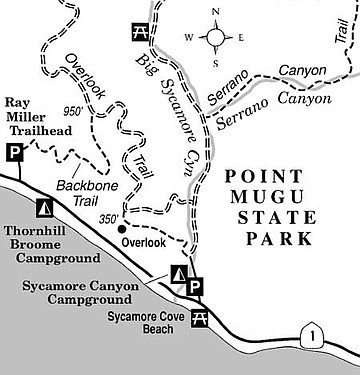 Facebook
Facebook
 X
X
 Instagram
Instagram
 TikTok
TikTok
 Youtube
Youtube
Point Mugu State Park, midway between Los Angeles and Ventura, sprawls across 15,000 acres of the coast-hugging Santa Monica Mountains. About 70 miles of hiking, biking, and equestrian trails lace through the park. Campers are accommodated in two coastal campgrounds, which are packed with visitors in summer, and a lot less crowded after Labor Day.
The Overlook Trail (a fire road), which curls up a hillside above the larger of the campgrounds -- Big Sycamore Canyon Campground -- offers ever wider views of the Pacific Ocean and the pillowy slopes that tumble down to the water's edge. An abbreviated looping trip (other, much longer options are possible) can take you swiftly up to the first significant "overlook" point, and is recommended for a hike timed to catch either the sunrise or the sunset. The fall and winter seasons offer the best times for viewing sunrises and sunsets for two reasons. First, the coastline here runs more or less east-west, so sunrises in particular do not take place over water except near the winter solstice. Second, the marine layer is often either thin or absent in the fall and winter.
North of the Big Sycamore Canyon Campground, just past a gate blocking vehicles, start hiking up the scenic trail on the left. You curve up a hillside and arrive after about 20 minutes at a saddle overlooking the ocean. Walk down to a little flat below for a better view. If you're game for it, you can make your way along the narrow ridge that rises to the southeast for an even better perspective. There you get (in daylight, anyway) an almost straight-down view of white, foamy surf and turquoise-tinted shallows. When the tide and surf conditions are just right, and the water's glassy, you can watch the swells reflect off the shore and head back out to sea, producing an ever-changing interference pattern of waves on the surface of the water. Note, too, the sloping blanket of sand nestled against the cliff below. This so-called "Great Sand Dune" is kept in place by prevailing sea breezes from the west and south.
When it's time to go, pick up the fire road that curves down the high ridge to the north -- the Overlook Trail. Follow its winding course downhill to Big Sycamore Canyon, turn right, and walk back to the campground. This wider, more gradually descending route is particularly helpful if you're returning in twilight after viewing the sunset. Deer frequent the slopes overlooking Sycamore Canyon, and they're particularly active at the beginning and end of each day.
This article contains information about a publicly owned recreation or wilderness area. Trails and pathways are not necessarily marked. Conditions can change rapidly. Hikers should be properly equipped and have safety and navigational skills. The Reader and Jerry Schad assume no responsibility for any adverse experience.


Point Mugu State Park, midway between Los Angeles and Ventura, sprawls across 15,000 acres of the coast-hugging Santa Monica Mountains. About 70 miles of hiking, biking, and equestrian trails lace through the park. Campers are accommodated in two coastal campgrounds, which are packed with visitors in summer, and a lot less crowded after Labor Day.
The Overlook Trail (a fire road), which curls up a hillside above the larger of the campgrounds -- Big Sycamore Canyon Campground -- offers ever wider views of the Pacific Ocean and the pillowy slopes that tumble down to the water's edge. An abbreviated looping trip (other, much longer options are possible) can take you swiftly up to the first significant "overlook" point, and is recommended for a hike timed to catch either the sunrise or the sunset. The fall and winter seasons offer the best times for viewing sunrises and sunsets for two reasons. First, the coastline here runs more or less east-west, so sunrises in particular do not take place over water except near the winter solstice. Second, the marine layer is often either thin or absent in the fall and winter.
North of the Big Sycamore Canyon Campground, just past a gate blocking vehicles, start hiking up the scenic trail on the left. You curve up a hillside and arrive after about 20 minutes at a saddle overlooking the ocean. Walk down to a little flat below for a better view. If you're game for it, you can make your way along the narrow ridge that rises to the southeast for an even better perspective. There you get (in daylight, anyway) an almost straight-down view of white, foamy surf and turquoise-tinted shallows. When the tide and surf conditions are just right, and the water's glassy, you can watch the swells reflect off the shore and head back out to sea, producing an ever-changing interference pattern of waves on the surface of the water. Note, too, the sloping blanket of sand nestled against the cliff below. This so-called "Great Sand Dune" is kept in place by prevailing sea breezes from the west and south.
When it's time to go, pick up the fire road that curves down the high ridge to the north -- the Overlook Trail. Follow its winding course downhill to Big Sycamore Canyon, turn right, and walk back to the campground. This wider, more gradually descending route is particularly helpful if you're returning in twilight after viewing the sunset. Deer frequent the slopes overlooking Sycamore Canyon, and they're particularly active at the beginning and end of each day.
This article contains information about a publicly owned recreation or wilderness area. Trails and pathways are not necessarily marked. Conditions can change rapidly. Hikers should be properly equipped and have safety and navigational skills. The Reader and Jerry Schad assume no responsibility for any adverse experience.
